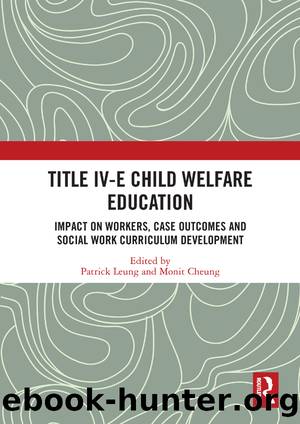Title IV-E Child Welfare Education by Patrick Leung Monit Cheung

Author:Patrick Leung, Monit Cheung [Patrick Leung, Monit Cheung]
Language: eng
Format: epub
ISBN: 9781032084114
Google: aRNnzgEACAAJ
Publisher: Taylor & Francis Group
Published: 2021-06-30T05:02:02+00:00
Introduction
Turnover in public child welfare agencies is expensive and associated with poor outcomes for children and families. Some national studies have estimated the rate of turnover between 40% and 57%, depending on the setting (US General Accounting Office [GAO], 2003; Wilson, Nichols, Kirk, & Wilson, 2010). When workers leave, they take their expertise with them and it takes a significant amount of time to have similarly well-trained employees ready to take over the case. Two estimates place the cost per vacancy at between $10,000 for posting and training a new worker (Graef & Hill, 2000) and $16,000 (Cowperthwaite, 2006). There are emotional costs as well for the workers left behind and the supervisors who are working hard to cover their units. Caseworker turnover has some damaging outcomes for children and families too. Ryan and colleagues (2006) found children had longer stays in care and decreased chances for reunification due to turnover. Decreased retention also has negative effects on meeting Federal timelines (Benton, 2016; US GAO, 2003). Clearly, turnover is a challenge that needs even more attention.
One bright spot in the effort to retain child welfare workers is the Title IV-E Program and the university/public child welfare agency partnerships (Mathias, Gilman, Shin, & Evans, 2015; Pierce, McGuire, & Howes, 2015). Specialized training, tuition support, and stipends have demonstrated positive effects for the retention of workers in public child welfare settings even after the pay-back periods have passed (Barbee et al., 2009; Rosenthal & Waters, 2006). MSW IV-E Scholars who receive training and educational opportunities report feeling more competent and prepared for the work (Ellett, Ellett, & Rugutt, 2003; Hartinger-Saunders & Lyons, 2013; Hopkins, Mudrick, & Rudolph, 1999).
Although the IV-E Partnerships have been funded for 40 years, there are not as many evaluation studies of the fundingâs efficacy as we might expect and fewer have focused on undergraduate training for child welfare practice. Very few studies have compared child welfare worker participants of Title IV-E program with non-IV-E participants regarding retention and child welfare competency. The current study compared perception of preparation of key child welfare competencies and retention of workers who had completed a BSW Title IV-E program and matched Trainees who did not.
Download
This site does not store any files on its server. We only index and link to content provided by other sites. Please contact the content providers to delete copyright contents if any and email us, we'll remove relevant links or contents immediately.
Harry Potter and the Goblet Of Fire by J.K. Rowling(3045)
Never by Ken Follett(2880)
Shadow of Night by Deborah Harkness(2718)
Ogilvy on Advertising by David Ogilvy(2682)
Zero to IPO: Over $1 Trillion of Actionable Advice from the World's Most Successful Entrepreneurs by Frederic Kerrest(2393)
The Man Who Died Twice by Richard Osman(2298)
Machine Learning at Scale with H2O by Gregory Keys | David Whiting(2290)
Book of Life by Deborah Harkness(2263)
How Proust Can Change Your Life by Alain De Botton(2261)
My Brilliant Friend by Elena Ferrante(2223)
0041152001443424520 .pdf by Unknown(2220)
The Tipping Point by Malcolm Gladwell(2204)
How to Pay Zero Taxes, 2018 by Jeff A. Schnepper(2099)
Will by Will Smith(2041)
Purple Hibiscus by Chimamanda Ngozi Adichie(1981)
Hooked: A Dark, Contemporary Romance (Never After Series) by Emily McIntire(1959)
Borders by unknow(1785)
Rationality by Steven Pinker(1765)
Daughter of Smoke and Bone by Laini Taylor(1744)
